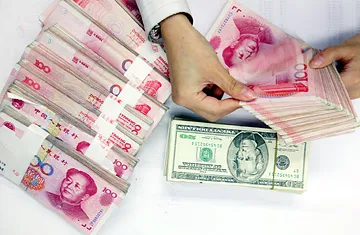
China’s local government debt reached RMB 10.7 trillion in 2010
About RMB 9 trillion, or 84% of the total was explicitly taken on or guaranteed by governments.
Bank lending accounts for about RMB 8.5 trillion of total local government debt, while bond issuance and other forms of financing make up the rest, says Royal Bank of Scotland.
Here’s more from RBSM:
| The updated figures on China's local government debt delivered little surprises and suggest most of the debt is state or state guaranteed debt, and was taken on to finance the large fiscal stimulus during the global financial crisis. The strong public sector balance sheet should help to ensure the repayment of the debt. China's National Auditor published China's public debt, including the most detailed breakdowns of local government debt to date. According to the Auditor, local government debt (including that raised by governments of provinces, municipals, and counties) stood at RMB 10.7 trillion at the end of 2010 (27% of GDP). Including the local government borrowing China's overall public debt stands at around 45% of GDP. More details: About RMB 9 trillion (84% of the total) was explicitly taken on or guaranteed by governments. The rest was likely to be implicitly guaranteed. Most of the debt by local government financing vehicles (LGFV) - about 46% of the total - carries an explicit government guarantee. About 40% of the debt needs to be repaid in 2011 and 2012, while the rest has a longer maturity. We estimate the average maturity to be about 3-4 years. How does this compare to the early market estimates of the debt? The magnitude of local government debt and banks' exposure is consistent with early estimates. The share of explicitly guaranteed debt is generally higher than what was earlier expected. Borrowing through LGFVs accounts for less than half of local government debt, and most of such borrowing has been either taken on or guaranteed by the government. Direct borrowing by local governments accounts for about 25% of the total debt. The maturity structure is more dispersed; on average slightly better. It was early estimated that most of the debt will need to be repaid in 2012 and 2013, implying an average maturity of 1-2 years. We estimate the average maturity is more than 3 years, as about 30% of the debt doesn't require repayment until after 2016. Proceeds from land sales are pledged for the debt repayment for 25% of the borrowing. Overall, the news doesn't affect our calls on the Chinese banking system and the implications for growth, as laid out in Top View | China | Chinese banks and growth. Indeed, the revelation that more than 80% of the debt is considered public and public guaranteed debt suggests that sovereign and sub-sovereigns stand behind these liabilities, which should help to lessen the concerns of default. The public sector balance sheet is strong, cash flows ample (including from land sales), and the probability of a wide-spread default of public debt is quite small. At the same time, however, the report brought to fore the structural weakness of China's public finances. At the moment, near half of local governments' spending rely upon central government transfers. For any shortfalls local governments need to raise the financing on their own, often outside of the budgetary process. Bringing all spending and financing by local governments into the budgetary process and introducing market-based mechanisms (for instance municipal bonds adequately monitored and rated) is needed for local spending controls, especially as local governments are likely to be the key players to carry out sizeable public and social investment in coming years. |



![SBR 5 Lorem Ipsum News 2 [8 May]](https://cmg-qa.s3.ap-southeast-1.amazonaws.com/s3fs-public/styles/exclusive_featured_article/public/2025-05/a_hand_pointing_to_a_futuristic_technology_5b87c9d0e3_3.png.webp?itok=M3Hf-9XR)
![SBR 4 Lorem Ipsum [8 May Top Stories]](https://cmg-qa.s3.ap-southeast-1.amazonaws.com/s3fs-public/styles/exclusive_featured_article/public/2025-05/a_hand_pointing_to_a_futuristic_technology_5b87c9d0e3_2.png.webp?itok=2m5Wl0MX)


![Exclusive three SBR 12 Lorem Ipsum [8 May]](https://cmg-qa.s3.ap-southeast-1.amazonaws.com/s3fs-public/styles/exclusive_featured_article/public/2025-05/a_hand_pointing_to_a_futuristic_technology_5b87c9d0e3_11.png.webp?itok=8kn_UIfA)
![SBR 3 Lorem Ipsum [ Exclusive 2]](https://cmg-qa.s3.ap-southeast-1.amazonaws.com/s3fs-public/styles/exclusive_featured_article/public/2025-05/a_hand_pointing_to_a_futuristic_technology_5b87c9d0e3_1.png.webp?itok=YCyjLegJ)
![SBR 2 Lorem Ipsum [8 May]](https://cmg-qa.s3.ap-southeast-1.amazonaws.com/s3fs-public/styles/exclusive_featured_article/public/2025-05/a_hand_pointing_to_a_futuristic_technology_5b87c9d0e3_0.png.webp?itok=_cKD-29o)

![Video [Event News]](https://cmg-qa.s3.ap-southeast-1.amazonaws.com/s3fs-public/styles/event_news_featured_article/public/2025-05/screenshot-2025-05-08-at-4.58.53-pm_0.png.webp?itok=Kud35sMs)
![Event News SBR 9 Lorem Ipsum [8 may]](https://cmg-qa.s3.ap-southeast-1.amazonaws.com/s3fs-public/styles/event_news_thumbnail/public/2025-05/a_hand_pointing_to_a_futuristic_technology_5b87c9d0e3_8.png.webp?itok=DTh_dbYp)
![Event News SBR 9 Lorem Ipsum [8 May]](https://cmg-qa.s3.ap-southeast-1.amazonaws.com/s3fs-public/styles/event_news_thumbnail/public/2025-05/a_hand_pointing_to_a_futuristic_technology_5b87c9d0e3_7.png.webp?itok=vzDAzb6V)
![Event News SBR 8 Lorem Ipsum [8 May]](https://cmg-qa.s3.ap-southeast-1.amazonaws.com/s3fs-public/styles/event_news_thumbnail/public/2025-05/a_hand_pointing_to_a_futuristic_technology_5b87c9d0e3_6.png.webp?itok=jvHFc4P6)
![Video [Event News]](https://cmg-qa.s3.ap-southeast-1.amazonaws.com/s3fs-public/styles/video_thumbnail/public/2025-05/screenshot-2025-05-08-at-4.58.53-pm_0.png.webp?itok=yZnI0YBb)
![Video 1 SBR [8 May]](https://cmg-qa.s3.ap-southeast-1.amazonaws.com/s3fs-public/styles/video_thumbnail/public/2025-05/screenshot-2025-05-08-at-4.58.53-pm.png.webp?itok=9AAeRz_k)

 Advertise
Advertise

